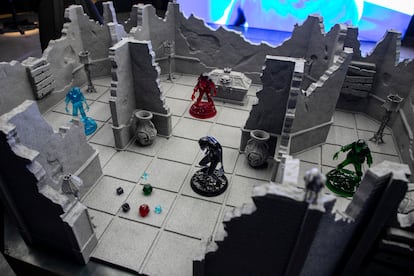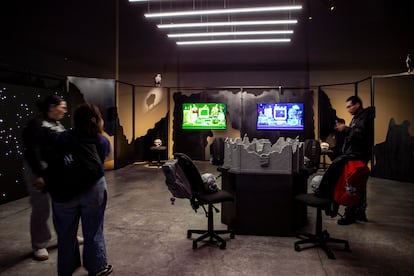Andrew Roberts (Tijuana, 1995) states that 2006 was crucial as a creator. Although he was a child, that year was important because he marked the arrival of Felipe Calderón to power and his ignominious war against the narco, which meant a revolcon in Mexico, with his family, neighbors, his city, marked by that burst of military violence, but it was also the year of irruption of violent video games, horror films made as an industrial chain by Hollywood and a commercial music that appealed to certain sensitivity to certain sensitivity, emothat the young people would call it. Growing up in that context, submerged for hours on the computer and video games, led him to question how the capitalist cultural industry helps to submit people and understood that it was important hack to the system.
From that reflection, an exhibition that Roberts has inaugurated at the University Museum of Contemporary Art (MUAC), which has entitled Ghost corpsea video installation that is based on a destroyed world after an apocalypse, with zombie teenagers and gamers as the artist, that they have resisted cataclysm in the form of living dead that are vestiges of a decadent era, razed by violence and rot created by a corporatist system. “This work makes a particular approach to youth, while exploring the way in which certain goods and video games draw a link with death as a spectral entity: a cross between material and dematerialized death that also part of the relationship between the technologies of the simulators used for the training of soldiers and in the video games of survival horror”, They explain from the MUAC.
Roberts states that the zombies of its installation are a kind of avatars. Those boys alienated by computer games, self -absorbed, imbued in a virtual world, remind him of his first youth. He spends many hours a day in front of the computer working, up to 12 while preparing his exhibition, with a day of rest a week. The sample is composed of a main screen that projects the image of a teenager who dances electrical, but melancholic music, with a blank view, while the speakers come out poems that are at the same time denounce about a violent reality, but also an exploration in the ways of how we see or understand death. In the exhibition there are cubicles with computers that evoke the popular cybercafés in the early millennium, where young people gathered for hours to play and navigate in that virtual world. All in a gloomy framework, of cataclysm, with crows in the corners that seem to evoke the gloomy world of Allan Poe.
Violence occupies a central space, like death. The violence exercised from the State, with a president seeking his legitimacy through a bloody war against drug trafficking that generated tens of thousands of dead and paralyzed northern Mexico, but also the violence manufactured in video games, some of them made by companies that create programs to train the US military who must then fight in wars. “Very perverse, but also fascinating meeting, that the company responsible for generating entertainment for adolescents and gamersit is also the one who is a participant in the murder of people outside the United States, “explains the artist.” What I try to establish with this project is how from my sensitivity these images of real violence intermingle with fictitious violence of video games, cinema and cartoons. For me 2006 is a year of violence, but particularly it is a year in which violence becomes very constant on the Internet, in news, in blogs, in images they took with cell phone and suddenly they became viral on platforms. What I do is take that as a starting point and try to explain how that may shape a generational sensitivity, ”explains Roberts.

The artist states that he has caught his attention how young people have felt attracted to their installation, which will be available until the end of November. The first days some boys approached him and told him that it was the first time they felt identified with a sample in the MUAC, which is a lot to say in the case of a university museum. Perhaps not only is the theme, so current, but the way in which the artist presents his work. “It invites us to become video game avatars and contrast our skin with the geometric meshes of an OBJ file and discern the self -determination that is felt by having our hands on the control of the video game as opposed to which we perceive in our feet when we advance in an unknown space. This mismatch dismou a notion of the notion of opposites to travel between them, to face the realities of a digital world impact on our bodies and the projection of a hybrid future where the tangible and virtual merge, ”explained Jaime González Solís, curator of the sample.
In this video installation there is criticism of violence, corporatism and “commercial forms of cultural production of neoliberalism,” but Roberts says he wants to break with a solemn idea of art and also explore the use of these technologies as a form of entertainment. “I have emphasized this exhibition that I am very interested in moving away from the yellow gamerbut it has to do with the company that is producing video games. For me it is very important to use those tools that are typical of video games to produce contemporary art, because it is a way to establish that these media do not necessarily alien, but also exist for entertainment, ”he explains.
However, the artist also wants to generate in their audiences, mainly the young women, a critical position with these technologies, because “these tools produce images that are made to direct people’s gaze and control it, how you can get out of that using the same technologies. And I am very interested that people understand the relationship between video games and war, or between technological entertainment and the financing of genocides,” says the artist who wants ‘to hack’ capitalist cultural production.

